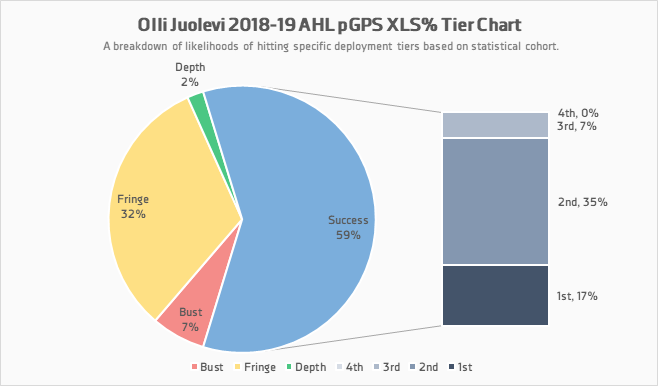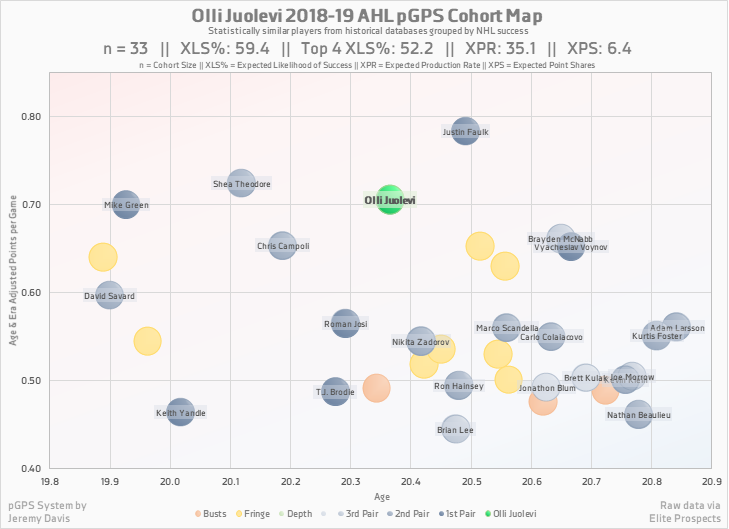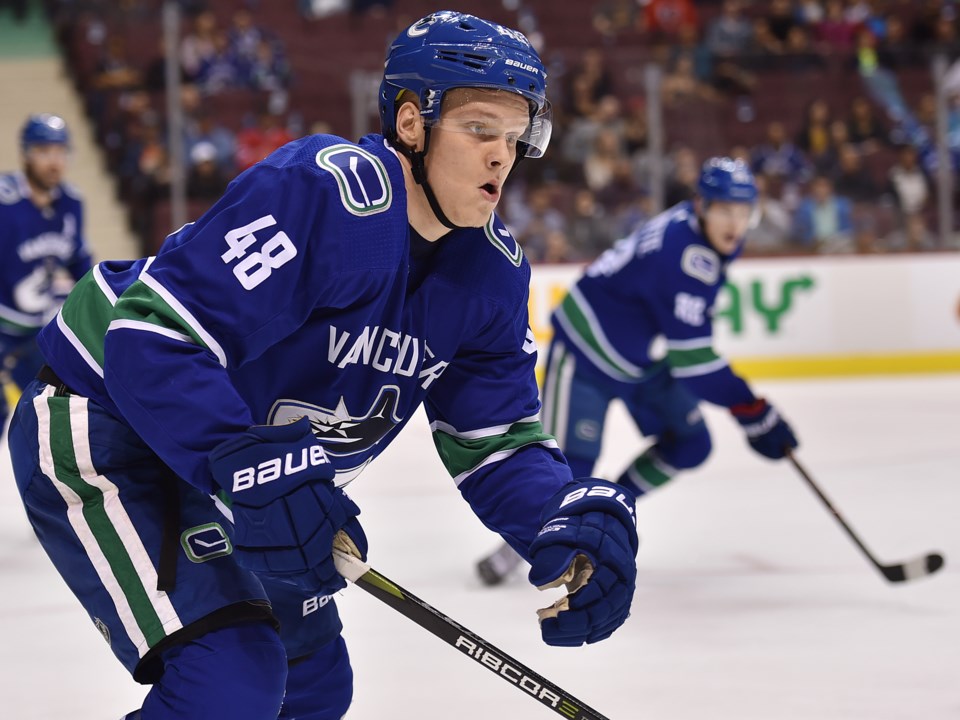When Sami Salo was the same age as Olli Juolevi is now, he hadn’t even been drafted yet.
That may sound crazy, but Salo wasn’t drafted until he was 21 and just a few months shy of 22. At the time, NHL teams couldn’t sign European players unless they drafted them, but the Ottawa Senators were in no rush to bring Salo over to the NHL after drafting him in the ninth round in 1996. He played two more full seasons in the Finnish Liiga before finally making his NHL debut at the age of 24.
Perhaps that can provide a little perspective when evaluating Juolevi, who just turned 21 in May. Salo went on to become a steady and reliable top-four defenceman for the Canucks after a 2002 trade, at least, when he was healthy.
That’s not to say that Juolevi will be as good as Salo, though that’s not an outrageous expectation, but that it’s a little too early to declare Juolevi a bust, as some Canucks fans have suggested of late. There were a few cries of dismay when I placed Juolevi on the second tier of the Canucks prospect pyramid along with Vasili Podkolziin and Thatcher Demko, but that's where he belongs. The truth is that Juolevi was the wrong pick at fifth overall — Matthew Tkachuk, Clayton Keller, and Mikhail Sergachev have pretty clearly made that argument — but he still has the potential to be a solid NHL defenceman.
Juolevi’s development hasn’t exactly been up to the expectations created by his draft position of fifth overall in 2016, but it hasn’t been terrible either. While he failed to take a step forward in his post-draft year, he had a strong season in Finland as a 19 year old, tallying 19 points in 38 Liiga games, while dominating in puck possession, then adding 7 points in 11 playoff games.
““He had a really good year,” said Salo, who was one of Juolevi’s assistant coaches in Finland. “He improved in the areas he needed, like in the defensive zone. He had a great playoffs, he carried the team after we lost a key defenseman. He took the team on his shoulders, we were really happy with his development.”
This past season was his first in the AHL and he pretty clearly needed some adjustment time defensively. Unfortunately, he never got that time, as his season was cut short by a knee injury that required surgery, despite initial assessments that it was a "minor knock." It was his second surgery in the space of a year after a microdiscectomy last June.
Offensively, however, Juolevi didn’t need any adjustment at all. He transitioned the puck up ice with the calm and poise we're used to seeing from him and he put up 13 points in 18 games before his injury. He played big minutes in all situations, including on the top power play unit, where he demonstrated his ability to walk the blue line and distribute the puck, as well as his improved shot.
Given the spate of injuries on the Canucks’ blue line, it’s a fairly safe assumption that Juolevi would have made his NHL debut last season, at the age of 20. On the Canucks defensive depth chart, he’s surely ahead of Ashton Sautner, who played 17 games, and Guillaume Brisebois, who played 8.
If Juolevi had played for the Canucks last season, even if only for a few games, there would likely be a lot less fuss over Juolevi’s development. Or, if he had played more than 18 AHL games and had an opportunity to improve his -12 plus/minus, he’d likely get less flak for his defensive performance.
It’s worth noting that all of Juolevi’s games were played without Thatcher Demko in net, as the Comets’ number one goaltender was injured. Instead, Ivan Kulbakov, Richard Bachman, and Connor LaCouvee tended the goal for the Comets in Juolevi’s 18 games. In those games, Kulbakov, Bachman, and LaCouvee combined for an .883 save percentage.
It’s fair to suggest Juolevi’s plus/minus might not have looked as bad if he had better goaltending behind him.
In any case, plus/minus isn’t a good statistic for multiple reasons. Besides, Zack MacEwen had the worst plus/minus on the Comets last season, and one of the worst in the AHL, and that hasn’t kept some corners of Canucks nation from pencilling him into the Canucks’ 2019-20 lineup.
The Canucks’ left side on defence is pretty much set for the start of the season: the Canucks re-signed Alex Edler and signed Jordie Benn and Oscar Fantenberg in free agency, while Quinn Hughes turned pro. That means Juolevi, barring injuries, will start the season in Utica again. He should still make his NHL debut next season at the age of 21 and that’s not a bad thing.
To show why that’s not a bad thing, let’s take a (somewhat) random sampling of top-end NHL defencemen. Of the 23 defenceman that received at least one vote for the Norris trophy last season, 10 of them didn’t make their NHL debut until they were at least 21, including Norris winner Mark Giordano. Another 10 (not necessarily the same 10) didn’t become full-time NHLers until they were at least 22.
Again, that doesn’t mean Juolevi’s going to be a Norris-caliber defenceman, just that it’s not an emergency that he has yet to play an NHL game.
So, who is comparable to Juolevi? We could look at this a couple different ways. For instance, you could go back to his last full season, which was in the Finnish Liiga, where he scored 0.50 points per game. That’s not too dissimilar from the performance of Sami Vatanen at the same age: 0.60 points per game.
The reason I bring up Vatanen is that when he came across to North America, he had an almost identical points per game in his rookie season in the AHL as Juolevi: 0.73 to Juolevi’s 0.72. The difference is that Vatanen was a year older than Juolevi and also that he did it over a much larger sample of more games. Vatanen didn’t become a full-time NHLer until he was 22, but became a top-four defenceman, with four seasons with 30+ points.
On the other hand, we can look at someone like Ville Pokka, who, like Juolevi, tallied 0.50 points per game in Liiga at 19, then came across to the AHL. He only had 0.44 points per game in the AHL at 20, then 0.59 points per game in the AHL at 21. He never made the NHL.
The point of these two comparisons is to show that a wide range of possibilities are open to Juolevi right now. He could be a top-four NHL defenceman like Vatanen or he could could crash and burn. A lot will depend on how he performs in the coming season.
Those two comparisons are just based on points, however. For some more comprehensive comparisons, I asked Jeremy Davis of NextGen Hockey, who helpfully provided some visualizations. He created the Prospect Graduation Probabilities System (pGPS), which uses nine different statistics to create a cohort of similar players for each prospect.
The output of pGPS comes in four different flavours: XLS%, iXLS%, XPR, and XPS.
- XLS%: Expected Likelihood of Success. This is the base value that is designed to indicate the likelihood of a player becoming a regular NHL player. That is, one of the top-12 forwards or top-6 defencemen on an NHL team.
- iXLS%: Impact Expected Likelihood of Success. This value is designed to determine the likelihood of a player becoming an impact NHLer: a top-6 forward or top-4 defender. An important note is that these values correlate highly with one another. That which makes a player more likely to be an NHL player at all also makes them more likely to be an impact player at that level. This point cannot be understated.
- XPR: Expected Production Rate. This is the expected rate of points per 82 games based on the players that make up the historical cohort (weighted by similarity).
- XPS: Expected Point Shares. This is the expected rate of point shares per 82 games, again based on the players in the historical cohort (and again weighted by similarity).
The first visualization is a simple pie chart of XLS%, showing that the most likely future for Juolevi is that of an NHL defenceman.

The possibility of Juolevi being an outright bust is tiny — just 7% — while a good chunk of the players in Juolevi’s cohort that went on to the NHL became second-pairing defencemen.
We can get some more precise numbers from pGPS, as well as the names of some of the players in Juolevi’s cohort in the next chart.

The numbers across the top of the chart provide some more detail. 59.4% of the players in Juolevi’s cohort became NHL players, while 52.2% became top-four defencemen. Expected point production across 82 games from Juolevi’s cohort is 35.1 points, which, I think, most Canucks fans would happily accept.
Some pretty compelling names pop up in Juolevi’s cohort, like Roman Josi, Justin Faulk, Keith Yandle, T.J. Brodie, and Shea Theodore. Of those, Josi bears the closest similarity to Juolevi according to pGPS.
Josi played his entire 20-year-old season in the AHL and didn’t make his NHL debut until he was 21, though he quickly established himself as a full-time NHLer. Now he’s a legitimate top-pairing defenceman, with six 40+ seasons under his belt, including 61 points in 2015-16.
That’s a best case scenario for Juolevi, but there are some cautionary tales among Juolevi’s cohort. For example, the players in Juolevi’s cohort with the closest similarity, higher than Josi, is Marc-Andre Gragnani.
Gragnani also made his AHL debut at 20, putting up 52 points in 78 games. While he was an AHL star, winning the Eddie Shore Award in 2011 as the league’s best defenceman, he never quite established himself in the NHL. He played 78 NHL games, 14 of them for the Vancouver Canucks during the 2011-12 season, before heading to the KHL.
Again, this shows the wide range of possibilities for Juolevi. Even though he hasn’t made the NHL yet, there’s still a very strong probability that he becomes not just an NHL defenceman, but a top-four defenceman. There’s also a lesser chance that he struggles at the fringes of making the NHL.
The same is true, however, of most NHL prospects. The fact remains that Juolevi is still a high-end prospect with plenty of potential.



